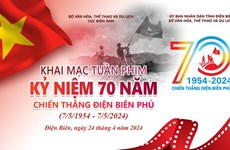Ethnic minority groups shelve traditional garb
Ethnic minorities are increasingly choosing not to wear their traditional costumes, especially for their daily activities.
Ethnic minorities are increasingly choosing not to wear their traditional costumes, especially for their daily activities.
The Muong Lo region, located in Nghia Lo town of northern Yen Bai province, is a concentration of the Thai people across Vietnam. Yet, it is uncommon to see a woman wearing the full garb of a traditional Thai costume – a long skirt and a tight blouse.
Most modern Thai women pair the traditional long skirt with either a T-shirt or shirts resembling those worn by the majority Kinh group. Thai men are typically outfitted in clothes worn by the Kinh.
Among the Mong people, images of Mong men wearing T-shirts and shirts are becoming increasingly popular. Mong women are no longer wearing skirts they have woven and embroidered by themselves. Instead, they use ready-to-wear skirts that can be easily bought at local markets with decorative patterns printed, not embroidered, on them.
Lo Thi Hoai, of the La Ha ethnic group in Thuan Chau district of northern Son La province, said she rarely wears her traditional costumes at home. She only wears them at festivals and on special occasions.
"I have only one set of the traditional costume," said Vi Thu Huong, who is from the Thai group living in the same district. "I wear popular clothes worn by the Kinh people every day and save the traditional set for special events only."
The problem of ethnic people wearing traditional costumes less often is more serious in the Central Highland region. Visiting a local village, tourists may wonder if they were in a residential area for the Kinh people since none of the residents wear their traditional costumes.
Elder Ama Hloan, of the E De group, said the locals wear traditional costumes only at festivals.
A recent study on the traditional weaving handicrafts of the Xo Dang group conducted in the districts of Dak To, Ngoc Hoi and Dak Ha in the Central Highland province of Kon Tum reveals that almost no traditional costumes were seen, said Bui Thi Thanh Van, director of the provincial Culture, Sports and Tourism Department.
According to Nguyen Thi Nga, director of the Vietnam Ethnic Groups' Culture Museum, 40 of the 54 ethnic groups across the country no longer wear their traditional costumes daily.
"Instead, they are wearing ready-to-wear mass-produced clothes," she said.
1001 reasons
Hoai explained that her traditional costume is very beautiful, but it's uncomfortable when working or performing domestic chores.
"Our traditional costume is not warm enough in the winter and too hot to wear in the summer," said Phung Ky Me of the La Hu group in Lai Chau province.
Lo Thi Van of the Thai group explained that she rarely wears her traditional blouse because it bears too many buttons, which take a long time to put on, and because it was too tight to wear while working.
A Than of the Brau group in the Central Highland province of Kon Tum shared this opinion, claiming the traditional costume for men is not convenient to wear while working or travelling through the forest.
The traditional garb comprises a short-sleeved shirt and a loin cloth. By wearing the whole outfit while working in the fields or trekking through the forest, one may get hurt by the trees, he remarked.
It's also more expensive to buy a traditional costume than a popular ready-to-wear one.
"To make the La Hu traditional costume, we have to raise the cotton plants ourselves, weave the cloth, dye it, embroider it, and then tailor it," said Me. "It takes around three months to complete a set, which costs around 5 million VND (240 USD)."
A long skirt for the Mong group also takes three to four months to finish. In the meantime, ready-to-wear clothes made of light, convenient, washable materials are easily available at reasonable prices.
"There are many (ethnic) groups living in my hometown," revealed Hung Thi Thoi of the Pa Then group in the northern province of Tuyen Quang.
"Everyone is wearing the majority Kinh group's clothes. If I wear my traditional costumes, I will be the odd one out, and it will be difficult for me to make friends."
Challenging task
Vi Kien Thanh, an official from the culture ministry, held that concerned agencies should focus on two groups to preserve the wearing of traditional costumes: women and students.
"Women often take care of the clothes worn by all their family members," he stated. "We can encourage students to wear traditional costumes as uniforms in local schools to enhance their pride in these costumes at a young age."
Weaving artisan Vang Thi Mai of the Mong ethnic group in the northern province of Ha Giang proposed that concerned agencies should facilitate ethnic groups in preserving the use of their traditional costumes.
"For example, we should get help with marketing and selling our weaving products," she remarked. "If we benefit from producing traditional cloth, we will be more enthusiastic."
Nguyen Tanh, director of Soc Trang province's Culture, Sports and Tourism Department, suggested regular costumed performances for ethnic minorities at local and national levels.
Tran Huu Son, director of Lao Cai province's culture department, pointed out that the first thing to do was to enhance the ethnic groups' awareness of the need to preserve their own traditional identity.
"Preserving ethnic groups' costumes and encouraging people to wear them is not a simple task," noted Hoang Duc Hau, an official from the culture ministry. "It requires cares and contribution from the whole community," he said.
The Muong Lo region, located in Nghia Lo town of northern Yen Bai province, is a concentration of the Thai people across Vietnam. Yet, it is uncommon to see a woman wearing the full garb of a traditional Thai costume – a long skirt and a tight blouse.
Most modern Thai women pair the traditional long skirt with either a T-shirt or shirts resembling those worn by the majority Kinh group. Thai men are typically outfitted in clothes worn by the Kinh.
Among the Mong people, images of Mong men wearing T-shirts and shirts are becoming increasingly popular. Mong women are no longer wearing skirts they have woven and embroidered by themselves. Instead, they use ready-to-wear skirts that can be easily bought at local markets with decorative patterns printed, not embroidered, on them.
Lo Thi Hoai, of the La Ha ethnic group in Thuan Chau district of northern Son La province, said she rarely wears her traditional costumes at home. She only wears them at festivals and on special occasions.
"I have only one set of the traditional costume," said Vi Thu Huong, who is from the Thai group living in the same district. "I wear popular clothes worn by the Kinh people every day and save the traditional set for special events only."
The problem of ethnic people wearing traditional costumes less often is more serious in the Central Highland region. Visiting a local village, tourists may wonder if they were in a residential area for the Kinh people since none of the residents wear their traditional costumes.
Elder Ama Hloan, of the E De group, said the locals wear traditional costumes only at festivals.
A recent study on the traditional weaving handicrafts of the Xo Dang group conducted in the districts of Dak To, Ngoc Hoi and Dak Ha in the Central Highland province of Kon Tum reveals that almost no traditional costumes were seen, said Bui Thi Thanh Van, director of the provincial Culture, Sports and Tourism Department.
According to Nguyen Thi Nga, director of the Vietnam Ethnic Groups' Culture Museum, 40 of the 54 ethnic groups across the country no longer wear their traditional costumes daily.
"Instead, they are wearing ready-to-wear mass-produced clothes," she said.
1001 reasons
Hoai explained that her traditional costume is very beautiful, but it's uncomfortable when working or performing domestic chores.
"Our traditional costume is not warm enough in the winter and too hot to wear in the summer," said Phung Ky Me of the La Hu group in Lai Chau province.
Lo Thi Van of the Thai group explained that she rarely wears her traditional blouse because it bears too many buttons, which take a long time to put on, and because it was too tight to wear while working.
A Than of the Brau group in the Central Highland province of Kon Tum shared this opinion, claiming the traditional costume for men is not convenient to wear while working or travelling through the forest.
The traditional garb comprises a short-sleeved shirt and a loin cloth. By wearing the whole outfit while working in the fields or trekking through the forest, one may get hurt by the trees, he remarked.
It's also more expensive to buy a traditional costume than a popular ready-to-wear one.
"To make the La Hu traditional costume, we have to raise the cotton plants ourselves, weave the cloth, dye it, embroider it, and then tailor it," said Me. "It takes around three months to complete a set, which costs around 5 million VND (240 USD)."
A long skirt for the Mong group also takes three to four months to finish. In the meantime, ready-to-wear clothes made of light, convenient, washable materials are easily available at reasonable prices.
"There are many (ethnic) groups living in my hometown," revealed Hung Thi Thoi of the Pa Then group in the northern province of Tuyen Quang.
"Everyone is wearing the majority Kinh group's clothes. If I wear my traditional costumes, I will be the odd one out, and it will be difficult for me to make friends."
Challenging task
Vi Kien Thanh, an official from the culture ministry, held that concerned agencies should focus on two groups to preserve the wearing of traditional costumes: women and students.
"Women often take care of the clothes worn by all their family members," he stated. "We can encourage students to wear traditional costumes as uniforms in local schools to enhance their pride in these costumes at a young age."
Weaving artisan Vang Thi Mai of the Mong ethnic group in the northern province of Ha Giang proposed that concerned agencies should facilitate ethnic groups in preserving the use of their traditional costumes.
"For example, we should get help with marketing and selling our weaving products," she remarked. "If we benefit from producing traditional cloth, we will be more enthusiastic."
Nguyen Tanh, director of Soc Trang province's Culture, Sports and Tourism Department, suggested regular costumed performances for ethnic minorities at local and national levels.
Tran Huu Son, director of Lao Cai province's culture department, pointed out that the first thing to do was to enhance the ethnic groups' awareness of the need to preserve their own traditional identity.
"Preserving ethnic groups' costumes and encouraging people to wear them is not a simple task," noted Hoang Duc Hau, an official from the culture ministry. "It requires cares and contribution from the whole community," he said.












